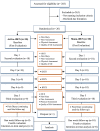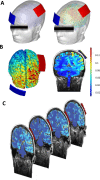Neuromodulation treats Chikungunya arthralgia: a randomized controlled trial
- PMID: 30375485
- PMCID: PMC6207669
- DOI: 10.1038/s41598-018-34514-4
Neuromodulation treats Chikungunya arthralgia: a randomized controlled trial
Abstract
The Chikungunya (CHIK) virus is epidemic in Brazil, with 170,000 cases in the first half of 2016. More than 60% of patients present relapsing and remitting chronic arthralgia with debilitating pain lasting years. There are no specific therapeutic agents to treat and rehabilitee infected persons with CHIK. Persistent pain can lead to incapacitation, requiring long-term pharmacological treatment. Advances in non-pharmacological treatments are necessary to promote pain relief without side effects and to restore functionality. Clinical trials indicate transcranial direct current stimulation (tDCS) can treat a broad range of chronic pain disorders, including diffuse neuromuscular pain and arthralgia. Here, we demonstrate that the tDCS across the primary motor cortex significantly reduces pain in the chronic phase of CHIK. High-resolution computational model was created to analyze the cortical electric field generated during tDCS and a diffuse and clustered brain current flow including M1 ipsilateral and contralateral, left DLPFC, nucleus accumbens, and cingulate was found. Our findings suggest tDCS could be an effective, inexpensive and deployable therapy to areas lacking resources with a significant number of patients with chronic CHIK persistent pain.
Conflict of interest statement
The City University of New York has patent on brain stimulation with MB as the inventor. MB has equity in Soterix Medical Inc.
Figures



References
-
- PAHO. Panamerican Health Organization. http://www.paho.org/usa/. - PubMed
Publication types
MeSH terms
Substances
LinkOut - more resources
Full Text Sources
Medical

